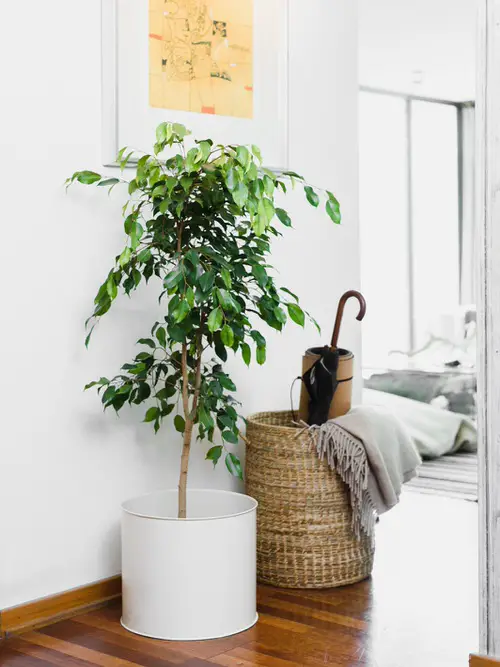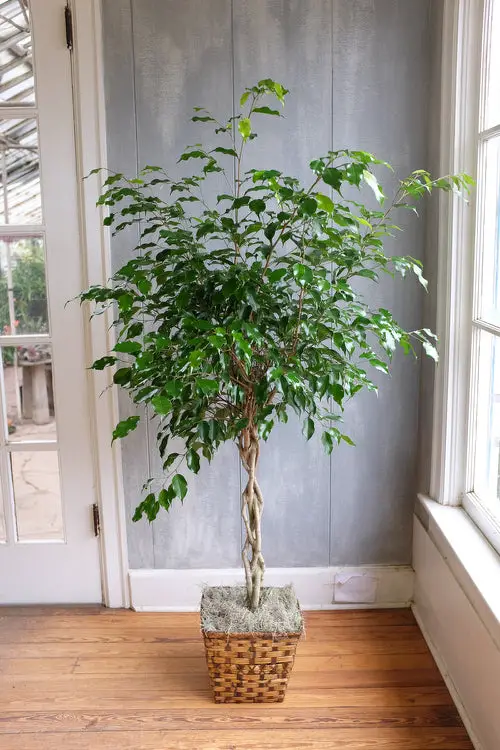Learn How to Grow Ficus Benjamina Indoors to liven up your space with its tropical vibes and lush foliage. Read on to know everything!

If you want a bold and beautiful plant that makes a stunning statement in your living room, then this is it! Read on to learn How to Grow Ficus Benjamina Indoors!
Botanical Name: Ficus Benjamina
Common Names: Weeping Fig, Ficus Benjamina tree, Benjamin Fig, and Benjamina Ficus
Here are the best types of indoor Ficus you can grow
Weeping Fig Information

Ficus Benjamina grows in the tropical and subtropical regions of Asia and Australia. Typically, to keep it as an indoor houseplant, it needs to be pruned to maintain a height between 3-7 feet.
People also braid its trunk to add to the aesthetic appeal indoors. Keep in mind that the sap of this charming tree is mildly toxic, so keep it out of reach of nibbling pets and playful children.
Have a look at the best large indoor plants here
Propagating Ficus Benjamina

You can propagate the plant easily from cuttings in Spring. Take 4-6 inches long cutting from a healthy plant. Make sure it has at least two sets of leaves. Get rid of the lower foliage and dip that end in a rooting hormone. Plant it in a pot with quality potting mix and cover the pot with a plastic bag.
Water it well and keep the pot in a bright spot that receives indirect sunlight. You should also mist the cutting every day to maintain ample humidity. You’ll notice growth in 2-4 weeks.
Best Ficus Benjamina Varieites
‘Danielle,’ ‘Naomi,’ ‘Exotica,’ ‘Golden King,’ ‘Starlight,’ ‘Twilight,’ ‘Blackie,’ and ‘Too Little’ are the best varieties you can grow indoors.
Best Pot Size for Growing Ficus Benjamina
It depends on the size of the plant you’re buying from the garden center. Usually, you can start the plant in an 8 to 12-inch pot. Just make sure the container has enough drainage holes at the bottom. Later, you can transplant it in a container (one size bigger) when it is time to re-pot.
8 Types of Indoor Ficus Benjamina Trees and Plants | Best Ficus Trees for Home
Requirements to Grow Ficus Benjamina Indoors
Sunlight
In its native tropical environment, it loves to grow in semi-shaded places with partial sunlight. Pick a bright corner with indirect sunlight in abundance. The plant wouldn’t mind 2-4 hours of direct sunlight. If you have an open room with big windows, it will grow happily.
Soil
Weeping figs are not demanding about the soil, but they thrive best in fast-draining soil. They’re not picky about the growing medium being high on organic matter or nutrients either – not even low. As long as you use a crumbly potting mix, the plant will do just fine.
Water
It is best to water the plant when the growing medium grows dry. Keep the soil evenly moist but do not overwater by saturating the soil every now and then. Soggy soil for a long time encourages the plant to wilt, shed leaves, and die due to root rot.
Temperature
Ficus Benjamin does best in a warm temperature range of 75-85 F (22-30 C) during the day and 65-70 F (18-21 C) during the night. Do not expose the plant to temperatures below 55 F (12 C).
Humidity
Weeping Figs love high humidity as they are tropical plants. Low humidity levels can lead to dry and shriveled-up leaves, but this, too, doesn’t affect the plant that much. Using a humidifier can be a good idea. You can also mist the leaves once every once in a while.
13 Best Chinese Indoor Plants
Ficus Benjamina Care

Fertilizer
Use a balanced liquid fertilizer once in 4-5 weeks in Spring and Summer. Feed the plant once in 2 months for the rest of the year. Do follow the instructions on the label. Side-dressing the plant with quality compost or manure once or twice a year is also a great idea.
Pruning
Give the Ficus tree a good prune to control its shape, especially when the tree is actively growing in summer and spring. Regularly remove dead and diseased leaves and entangled or misdirected branches to maintain their shape and stop the spread of fungal infections and diseases.
Pests & Diseases
Sometimes the dropping of leaves can be due to pest infestation by mealybugs, scale, aphids, and spider mites. Spider mite infestation is one of the major issues, so keep an eye on them. Use an insecticidal soap or neem oil solution to take care of them.
Ficus pumila quercifolia Growing Guide | String of Frogs Care
Common Problems With Ficus Benjamina
The most common trouble with the otherwise easy-to-care-for Weeping Fig is the dropping of leaves. The tree can lose out on its leaves due to stress. Here are common causes of stress for the plant and what it means.
- Lack of Nitrogen: It needs a fertilizer rich in nitrogen.
- Underwatering: Water the plant. Stop leaving the topsoil dry completely.
- Low Light: Change its position and keep it in a well-lit area.
- Frequent Temperature Changes: Protect it from drafts and extremes.
- Repotting: Repot only when necessary. It prefers being slightly root-bound.
- Overwatering: Let the topsoil dry a bit (not completely) before watering again.
If you’ve meddled with the plant or changed your routine, you can tell the reason behind the leaves dropping and take care of it.



